
"Tuscan Patchwork", Oil, 6x8"
Not much painting this week. After briefly traveling to Texas for a long weekend celebrating my mom's birthday (happy 80th Mom!) I returned to spend the week FINALLY tackling the mountain of paperwork I've had on my "to-do" list for some time.
I used to think I was pretty organized in my art business, but lately I feel like I am forever playing "catch up". There was a time during my studio move when I was literally operating out of boxes. But I'm all set up now and I really can't blame my floundering on the move any more. The only explanation I really have to offer is that during my little break from the routine I'd set up for myself, I developed the bad habit of....well....not having a routine!

"White Road in Val d'Orcia", Oil, 6x8"
I recall a conversation I had some time ago with a gallery owner. I was admiring the work of a fellow artist in the gallery and commenting on how much this artist's work had grown and matured. The gallery owner agreed. They were good paintings, and popular with collectors too. If only they could get the artist to give them more work!
As it turned out, the artist had just recently changed from being a part-time painter with a day job to being an artist full-time. Only, this person was anything but, watching movies, surfing the net--doing most anything rather than painting. According to the gallery owner, ironically, once given the luxury of unlimited time, the artist's productivity plummeted. I could understand this.
So many artists I know can so easily get into the habit of working toward deadlines. But when no deadline looms, (no shows, openings, classes or other projects on the horizon) their commitment (and often their work) can languish. I'm sure all working artists with kids and/or day-jobs everywhere are playing the world's tiniest violin in sympathy! But there is something to be said for having externally imposed time limits.
Of course there are many possible reasons why artists don't create (such as emotional constraints brought on by fear, insecurity, depression, etc.) But when I had a day job, I was forced to carve out a finite amount of time in which to do my creative work, and looking back I am amazed at how productive I was. I remember being up until 2 a.m. painting, even after a full day of work at the bank, going to the gym, showering, and scraping together some dinner (I also remember being single then, and younger too!) Of course, I lamented not having more time to paint, but at the same time, my time limitations lit a fire under me to make the most of each window of opportunity.
But once I started working full time at my painting, I, too, languished for a time due to complete lack of structure and many, many distractions around the home studio. Being the ADD sort that has many other interests doesn't help! What did finally help me was that I began to structure my business in such a way that it set exteral limitations and schedule requirements. But I may have overdone it a bit. I traveled a lot, I maintained a rigorous work schedule to supply work to the 8 galleries I was working with at the time. And when that wasn't enough busy-ness for me, I taught classes, maintained my website and blog, and eventually opened a studio-gallery with montly shows.
But here's the thing. Even though for a while, the money was good and the trips were fun, ultimately this "system" didn't work for me either. Everything was urgent and important, and constantly being in emergency mode was like going from zero to 100 with no brake in between. And you know what can happen when you speed along at 100 miles/hour? Crash. (Of course you can also crash going 20 miles/hour, but it doesn't hurt nearly as much.)
A part of me began to realize what I was doing, so I began eliminating again. Fewer galleries, fewer trips, and eventually letting go of the downtown space and again setting up a home studio. But what I hadn't realized (or had forgotten) was that eliminating much of the externally imposed deadlines and obligations without creating an internal structure to replace it would leave me feeling more lost and disorganized than "free."
Many of you readers out there are probably familiar with Stephen Covey's book The 7 Habits of Highly Effective People . It's become a real classic in the business/success genre, and I'd heard his audio version
. It's become a real classic in the business/success genre, and I'd heard his audio version many years ago but had rather forgotten about it until recently. My favorite part of the book is "Habit 3: Putting First Things First," which includes his famous "Time Management Matrix":
many years ago but had rather forgotten about it until recently. My favorite part of the book is "Habit 3: Putting First Things First," which includes his famous "Time Management Matrix":
|
Urgent |
Not Urgent |
|
Important
|
Quadrant I (crises, deadlines) |
Quadrant II (planning, relationships, R&R) |
|
Not Important
|
Quadrant III(interruptions, some calls, etc.) |
Quadrant IV(trivia, busy work, time wasters) |
According to Covey, Quadrant II is the place where "successful people" spend the bulk of their time. This Quadrant is filled with proactive things like planning and prevention, as well as growth activities like relationships and recreation (and many creative pursuits!) Instead, Quadrant I tends to be where most people spend their time (crises, deadlines, etc. --AKA emergency mode.) I don't think I'd be too far afield if I said that there are many artists who hang out in this quadrant. I've seen it in myself, and I have known many artists, both professionals and beginners who do not even work at all unless they have an external deadline to work toward (art exhibit, workshop, etc.)
Having externally motivated goals isn't always a bad thing. But, at least for me, it's dangerous if it becomes too much of a habit. In fact, some of us can get so addicted to emergencies (ahem!) that we tend to put off Quadrant II activities until they become Quadrant I activities. And then we get so freaked out and exhausted that we escape to Quadrant IV!
If you're still with me, I'll tell you what all of this Quadrant stuff has to do with art (or at least my art.) Pretty much every goal I have as an artist and as an individual has associated tasks that can ideally be categorized as a Quadrant II activities-- from health goals like proper diet, exercise and adequate sleep, to artistic goals like x number of plein air paintings/ week, and things like experimenting with different mediums, subject matter, or techniques. And if the tasks are managed properly from the get-go, they need never become "urgent" Quadrant I's.
Quadrant I stuff happens. Sometimes even in spite of their best efforts, people lose their jobs, get sick, or just plain forget to deal with things. But while not every emergency is predictable or preventable, I am fortunate to be able to say that, at least at this time, many of them are. I can prevent stress by getting adequate sleep and exercise. I can prevent freaking out before a show or a workshop by planning and/or preparing for it with a calm and steady production flow in advance. I can position myself for success and future opportunities, even if right now business has slowed. For me, the most obvious path to keeping myself focused on important things before they become urgent, is to create a daily schedule that whittles away Quadrant I and includes as many Quadrant II actvities as possible. I've mentioned this before, but here's the key; you gotta stick to it! In short, it's called discipline. And the last time I checked, discipline requires commitment, not just saying "I'll try."
Ultimately the whole art/artist thing wreaks to high heaven of Quadrant II. I'd venture to say that even for those of us who depend on their art sales as their sole source of income, the vast majority of artists are doing their work first and foremost out of love for it. After all, if it were just about the cash, there are many more efficient ways of making more money in less time.
Will we die without being able to create our art? Will others die without being able to experience it? Well, in reality art doesn't have that kind of urgency. But if life is to be truly enjoyed, we have to move beyond merely surviving to thriving, which for me includes being uplifted, challenged, or inspired. That's the benefit of art, and in that way, it is so very important.
p.s. By the way...I did manage to eek out a couple of small Tuscany studies, playing with the idea of pattern. You can now see purchasing details for these and the other two small paintings mentioned in my previous post by clicking here.
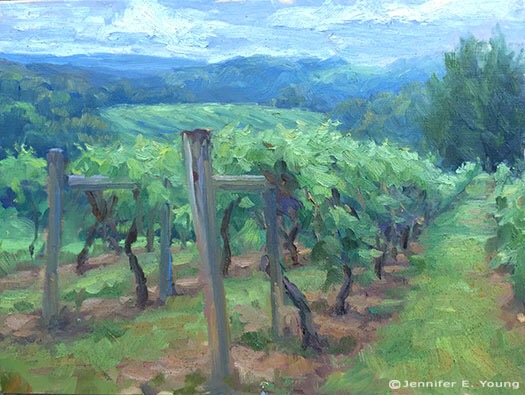 "Vineyard in Gray Light", oil on panel, 9x12"
"Vineyard in Gray Light", oil on panel, 9x12" "Buffalo Mountain View", oil on linen, 8x8"
"Buffalo Mountain View", oil on linen, 8x8"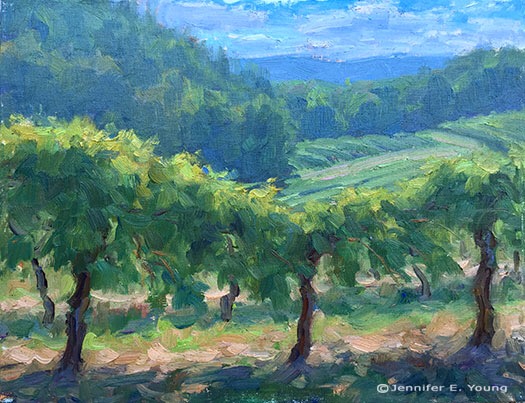 "Sunlit Vines", oil on linen, 9x12"
"Sunlit Vines", oil on linen, 9x12"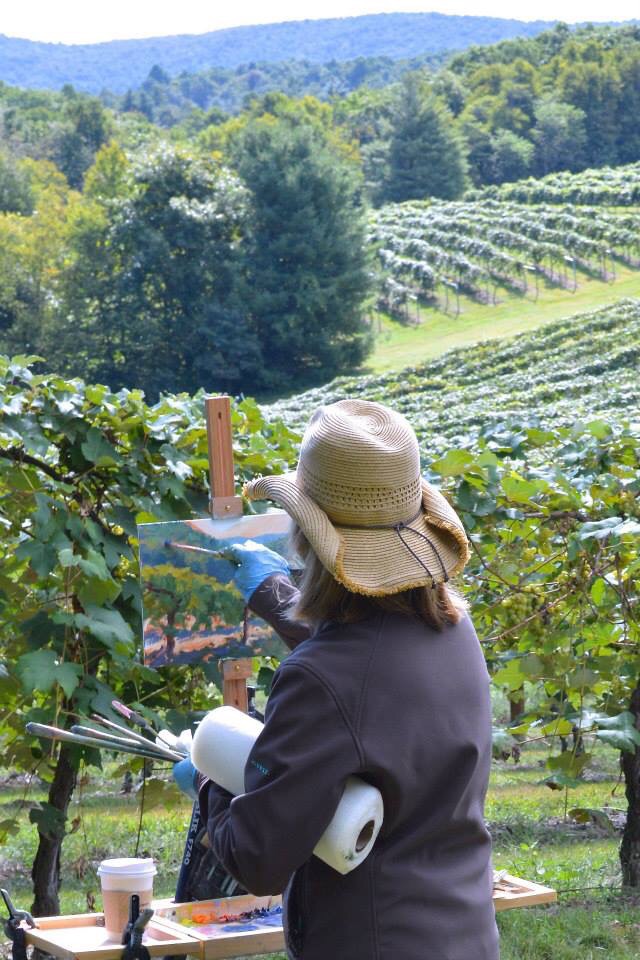
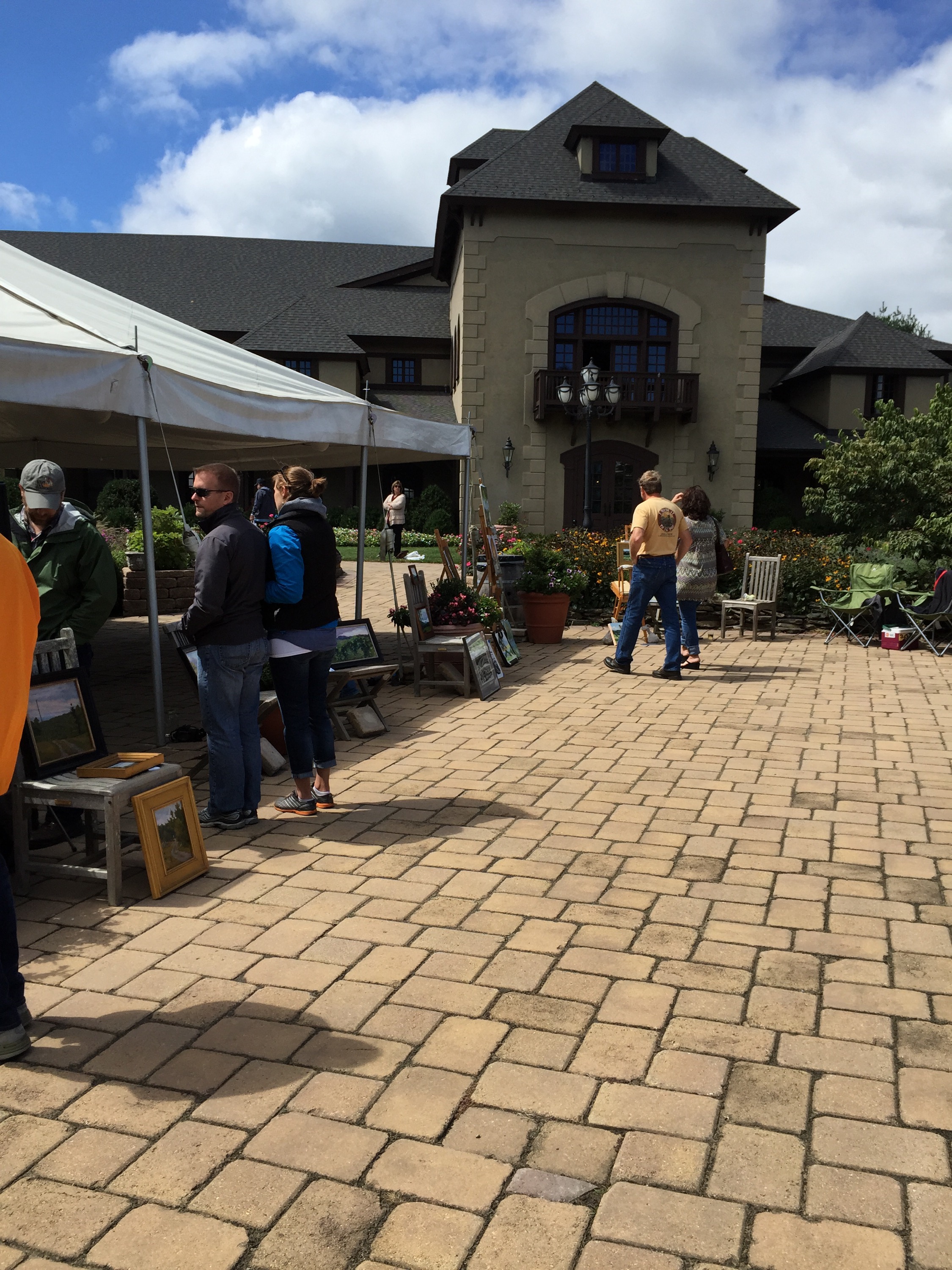 Setting up for the judgement back up at the winery
Setting up for the judgement back up at the winery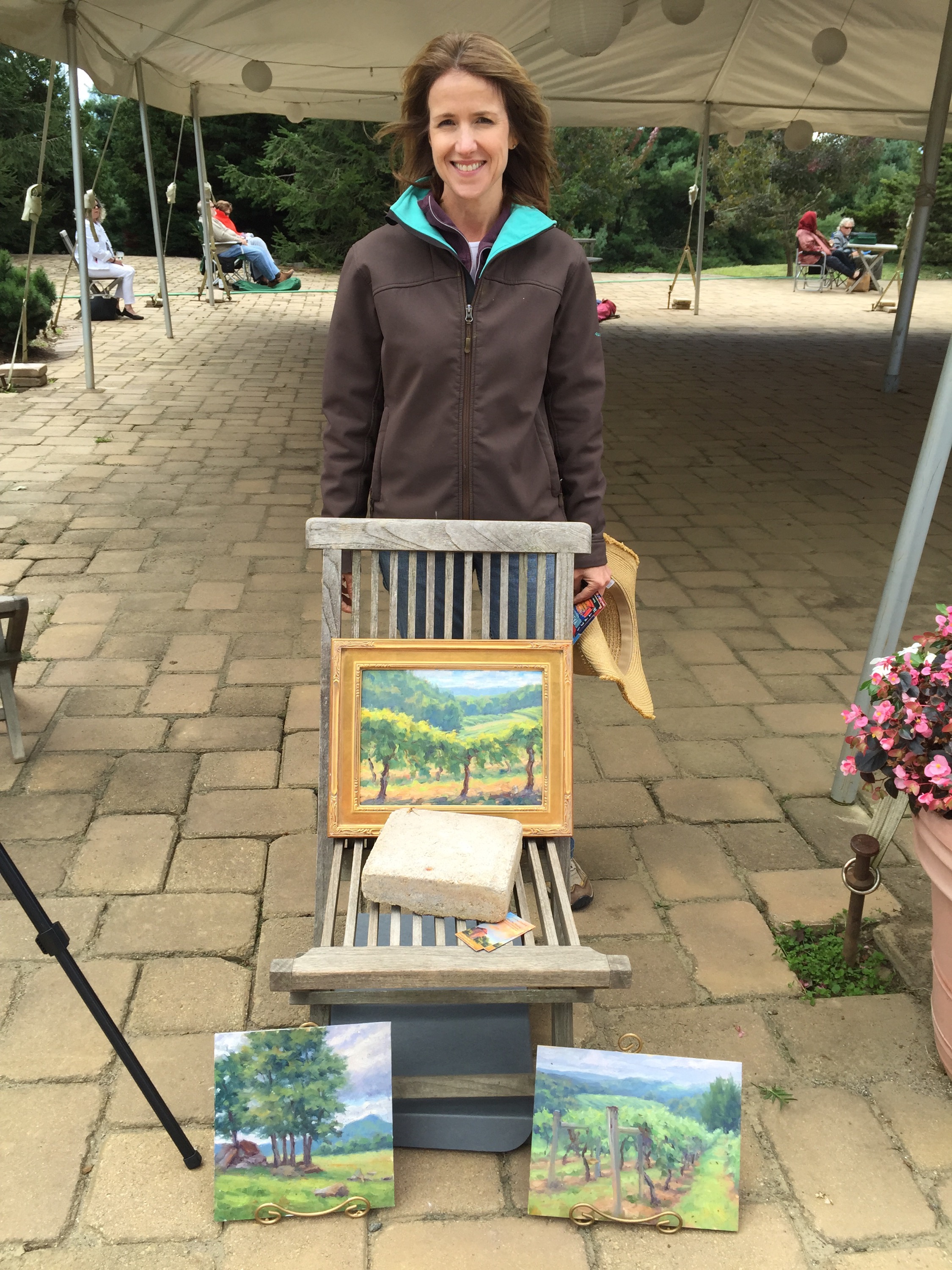 Here I am happy and tired. The wind blew up a bunch of dirt on my paintings. I have managed to get most of it off of the two vineyard pieces, but the Buffalo Mountain one was painted really thickly and I don't think that stuff is going to budge. Oh well...that's plein air for you! It was good winery soil at least.
Here I am happy and tired. The wind blew up a bunch of dirt on my paintings. I have managed to get most of it off of the two vineyard pieces, but the Buffalo Mountain one was painted really thickly and I don't think that stuff is going to budge. Oh well...that's plein air for you! It was good winery soil at least.
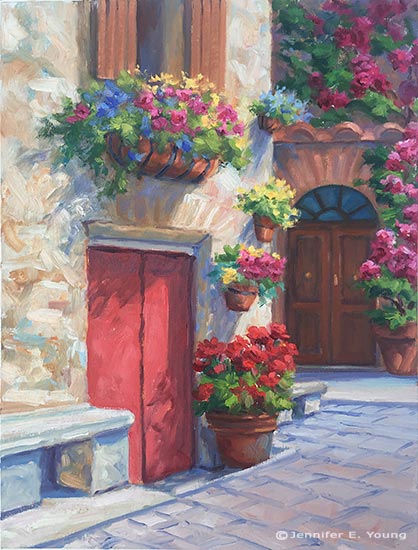
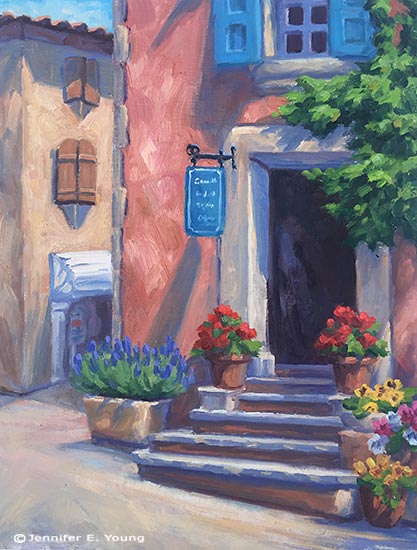 "The Corner Shop, Roussillon", Oil on Linen, 16x12"
"The Corner Shop, Roussillon", Oil on Linen, 16x12"

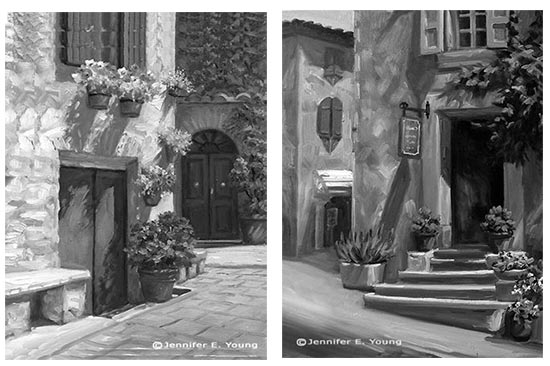
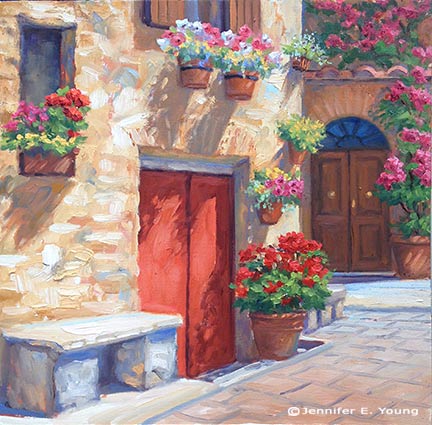

 "Splash of Color"
Oil on Multimedia Artboard, 6x8"
"Splash of Color"
Oil on Multimedia Artboard, 6x8"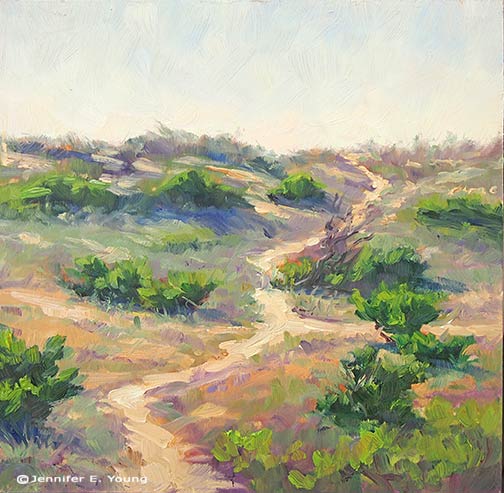
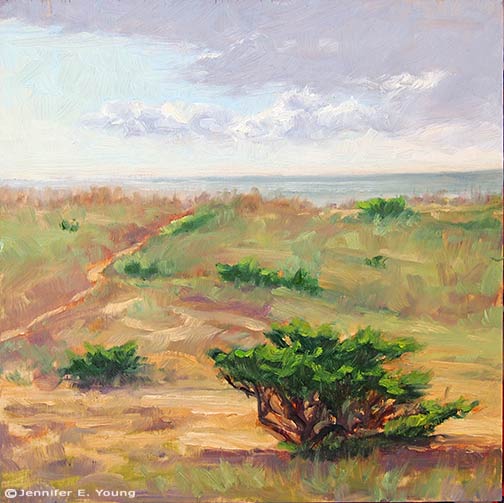
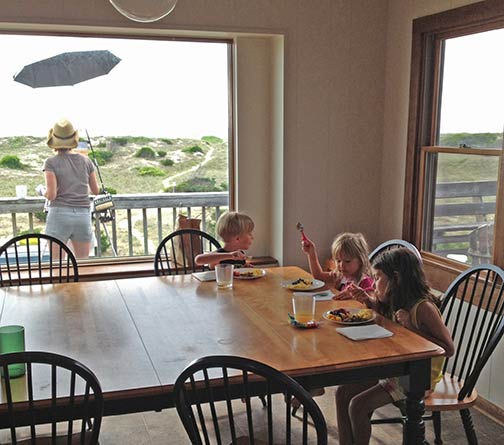



 So now I have the whole canvas covered. I started in on some of the details sooner than I would have liked, but there were a few breaks in the continuity of my painting sessions that compelled me to tackle certain areas while they were still wet. Over the next session or two I'll be finalizing the background mountains and fleshing out the flowerbeds. I'm going to do my best to finish this up in advance of Christmas. School's out for a couple of weeks for Christmas break so my studio time is about to get a lot more dicey.
So now I have the whole canvas covered. I started in on some of the details sooner than I would have liked, but there were a few breaks in the continuity of my painting sessions that compelled me to tackle certain areas while they were still wet. Over the next session or two I'll be finalizing the background mountains and fleshing out the flowerbeds. I'm going to do my best to finish this up in advance of Christmas. School's out for a couple of weeks for Christmas break so my studio time is about to get a lot more dicey. 







 . It's become a real classic in the business/success genre, and I'd heard his
. It's become a real classic in the business/success genre, and I'd heard his  many years ago but had rather forgotten about it until recently. My favorite part of the book is "Habit 3: Putting First Things First," which includes his famous "Time Management Matrix":
many years ago but had rather forgotten about it until recently. My favorite part of the book is "Habit 3: Putting First Things First," which includes his famous "Time Management Matrix":










